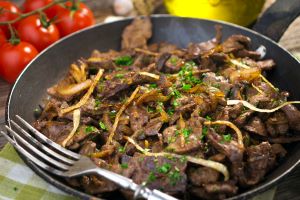Vitamin A is best known for helping you see better, especially at night.
But this often-overlooked nutrient has dozens of other health benefits. Your muscles, immune system, lungs, and kidneys all use it, and your liver stores it to use in an emergency.
And now scientists have discovered that vitamin A also activates a stockpile of previously unknown, heart-healing cells inside your pericardium, the fluid-filled sac that surrounds your heart.1,2
First, the researchers discovered that these special cells – a subtype of white blood cells called macrophages – helped heal the hearts of mice.
Then they discovered we have these same special cells in the pericardium sac around our hearts.
The researchers knew that other organs in the body are surrounded by these fluid sacs, but this was the first time the heart was discovered to have one.
That’s big news. If you or a loved one has ever suffered a heart attack, you know that one of the biggest obstacles to recovery is damage to the heart muscle.
These macrophages are cellular versions of a heart first-aid kit. They rush to the injury site without using the bloodstream because the cells are outside your heart.
At the very least, this new discovery should change how heart surgeons operate. They now need to take greater care not to remove the pericardium sac, thus preventing your body’s natural heart-healing cells from doing their job.
But this discovery also means that you can use vitamin A to trigger these healing macrophages into action.
Let me explain… Vitamin A is actually a group of compounds called retinoids – the bioactive form of the vitamin.
Retinoids regulate how many cells are created, how they grow, how long they live, and how they develop. Some retinoids are also critical signaling molecules in your body.
Recent
studies on the peritoneal – the fluid sac that surrounds the organs in your abdomen – revealed that a key bioactive metabolite of vitamin A called retinoic acid provides the signal for macrophages to quickly ride to rescue damaged organs.3You may have already heard of retinoic acid. It’s found in many lotions for skin wrinkling.
Retinoic acid is basically a more potent version of retinol, a common over-the-counter version of bioactive vitamin A that you’ll find in skin anti-aging creams and lotions. In your body, retinoic acid is synthesized from retinol.
Now, your doctor may have warned you about the awful dangers of vitamin A. Symptoms like dizziness, nausea, headaches, fatigue, and anemia.
What they DON’T tell you is that drug companies make synthetic forms of vitamin A and market them as drugs. They’re hoping you’ll trust their drug version instead of natural vitamin A.
You see, Big Pharma can’t make any money off vitamin A because it’s natural, and they can’t patent it. So they tell you it’s dangerous.
But here’s the truth…
The dangers of vitamin A only exist in extremely high doses – and most of Big Pharma’s evidence comes from misleading studies sponsored by the drug companies.
Our primal ancestors got ten times more vitamin A from their food than we get today.4
If you’re deficient in vitamin A, most doctors – when they’re not warning you against it – will tell you to eat carrots and orange vegetables, like squash and bell peppers. But these aren’t your best source.
You see, orange and red vegetables contain beta-carotene. It’s called a “pro-vitamin A.”
Your body has to convert it to retinol – but it doesn’t make the conversion very efficient.
For every six units of beta-carotene you eat, you only get 1 unit of vitamin A. Even if you consumed 25,000 units of beta-carotene, you wouldn’t get enough for the day.
Here’s what I tell my patients:
The best way for your body to produce enough retinoic acid is to get your vitamin A from animal products and animal fats. These contain high quantities of “preformed” vitamin A.
Great sources of preformed vitamin A include lamb liver, cod liver oil, king mackerel, salmon, butter, and eggs.
But the best source is grass-fed beef liver. In fact, 100 grams provides 53,400 IUs of vitamin A.
Some people turn up their noses when you mention serving liver. But after you try this recipe, I’m convinced you’ll be converted:
Ingredients:
➤ 1 pound grass-fed beef liver
➤ 1 large onion, sliced
➤ 4 strips of uncured bacon
➤ 2 tbsp ghee
➤ 1 tbsp coconut oil
➤ 1 tsp each salt and pepper
Directions:
 I’ve found that even people who say they don’t like liver end up loving this dish. I’ve found that even people who say they don’t like liver end up loving this dish. |
Fry bacon on medium heat and set aside. Leave grease in your pan and lower to medium-low.
Add 1 tbsp ghee to bacon grease and heat. Add sliced onion and allow to brown, stirring often, until caramelized. This takes about 30 minutes.
Add coconut oil and remaining ghee to your skillet and bring up to medium-high heat. Sauté liver 2 -3 minutes per side. It’s ready when it springs back from your touch.
Remove from heat and smother with onions. Crumble the bacon on top and serve.
Of course, you can always supplement. I recommend you get at least 5,000 IU – the equivalent of 1,500 mcg – daily to keep your body’s inbuilt heart-healing powers in tiptop condition.
To Your Good Health,
![]()
Al Sears, MD, CNS
References:
1. Deniset JF, et al. “Gata6+ pericardial cavity macrophages relocate to the injured heart and prevent cardiac fibrosis.” Immunity, 2019; 51 (1): 131
2. Wang J, et al. “A reservoir of mature cavity macrophages that can rapidly invade visceral organs to affect tissue repair.” Cell . 2016: 165, 668–678
3. Okabe Y, Medzhitov R. Tissue-specific signals control reversible program of localization and functional polarization of macrophages. Cell. 2014. 157:832–44.
4. Price WA. “Nutrition and Physical Degeneration.” New York: Paul B. Hoeber, Inc., 1939.
